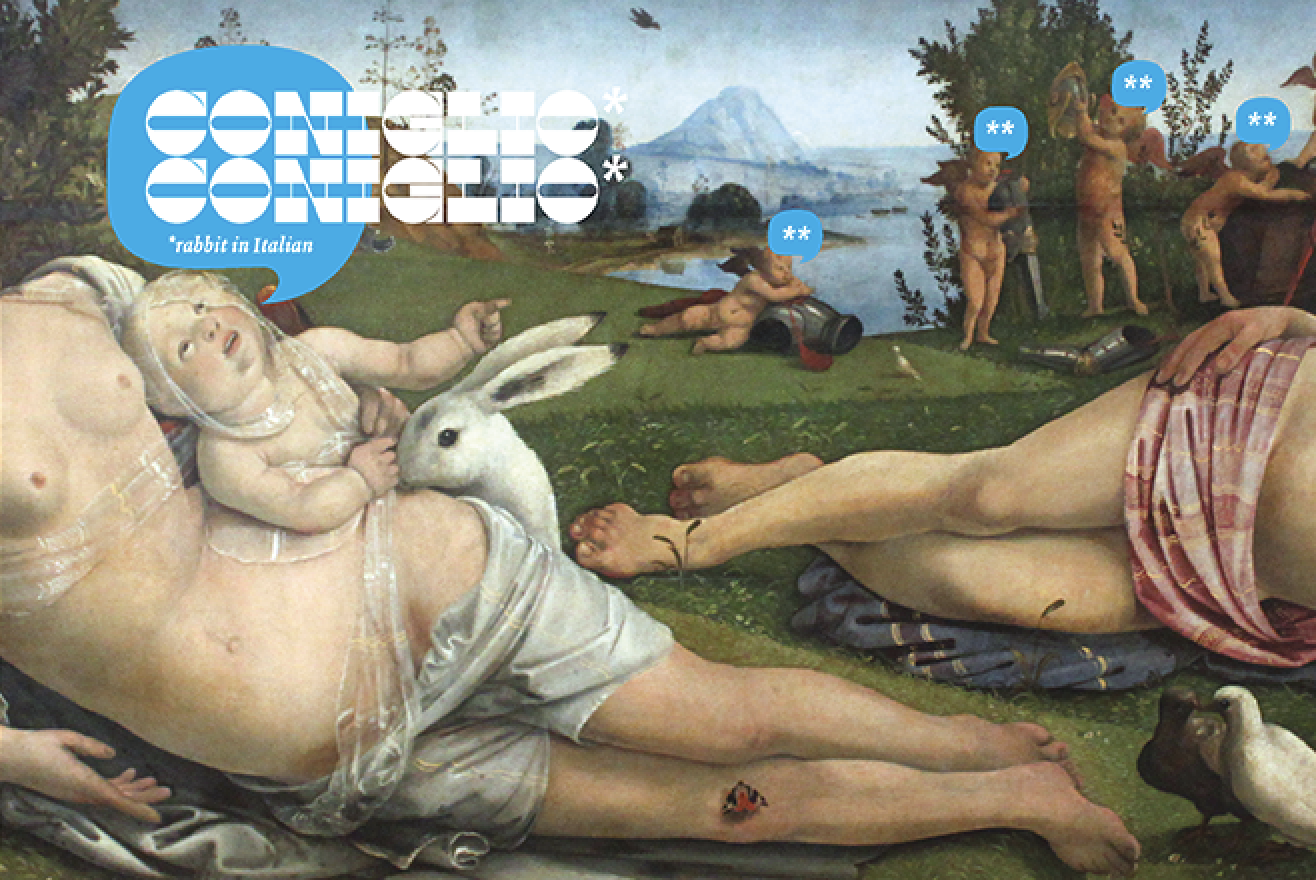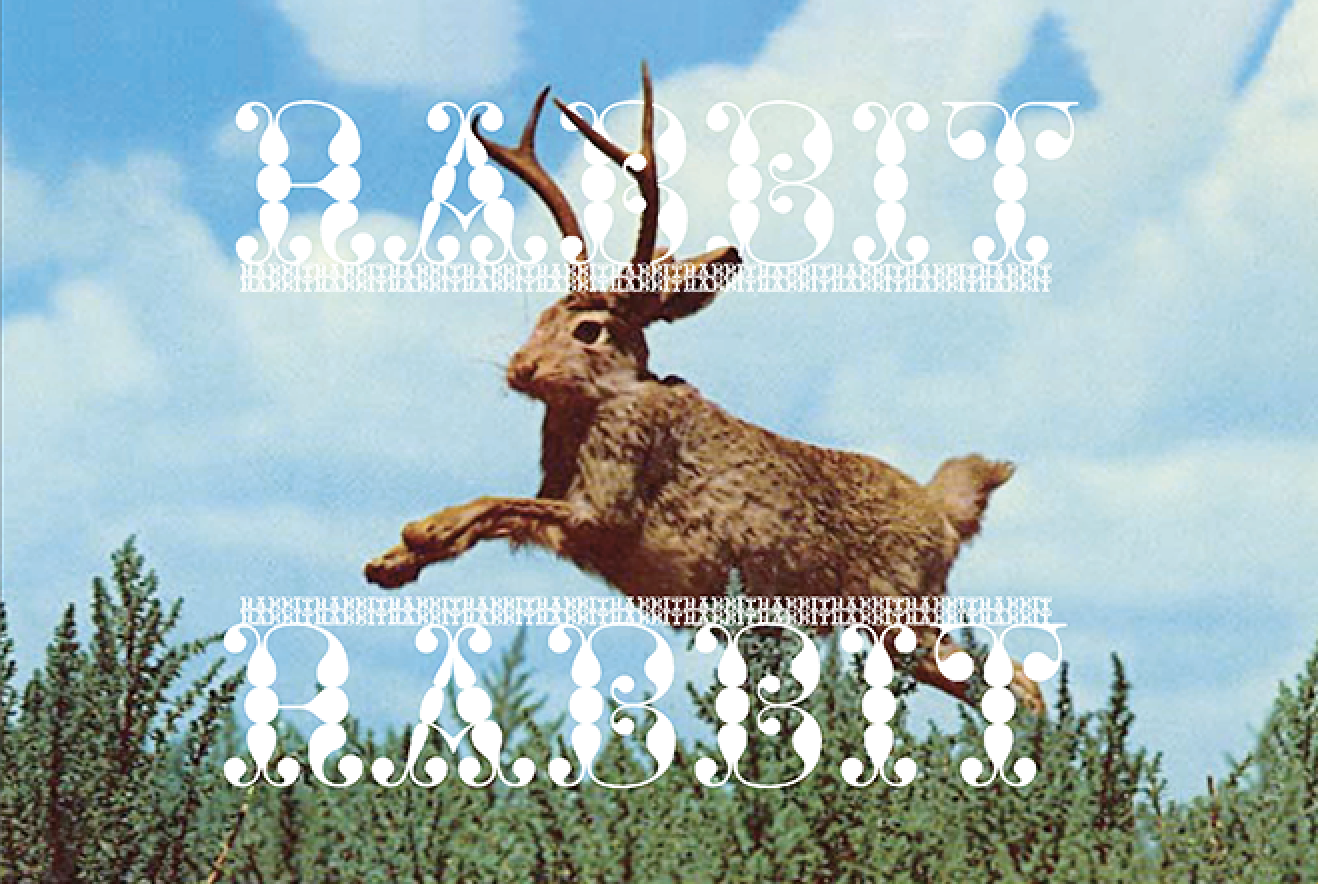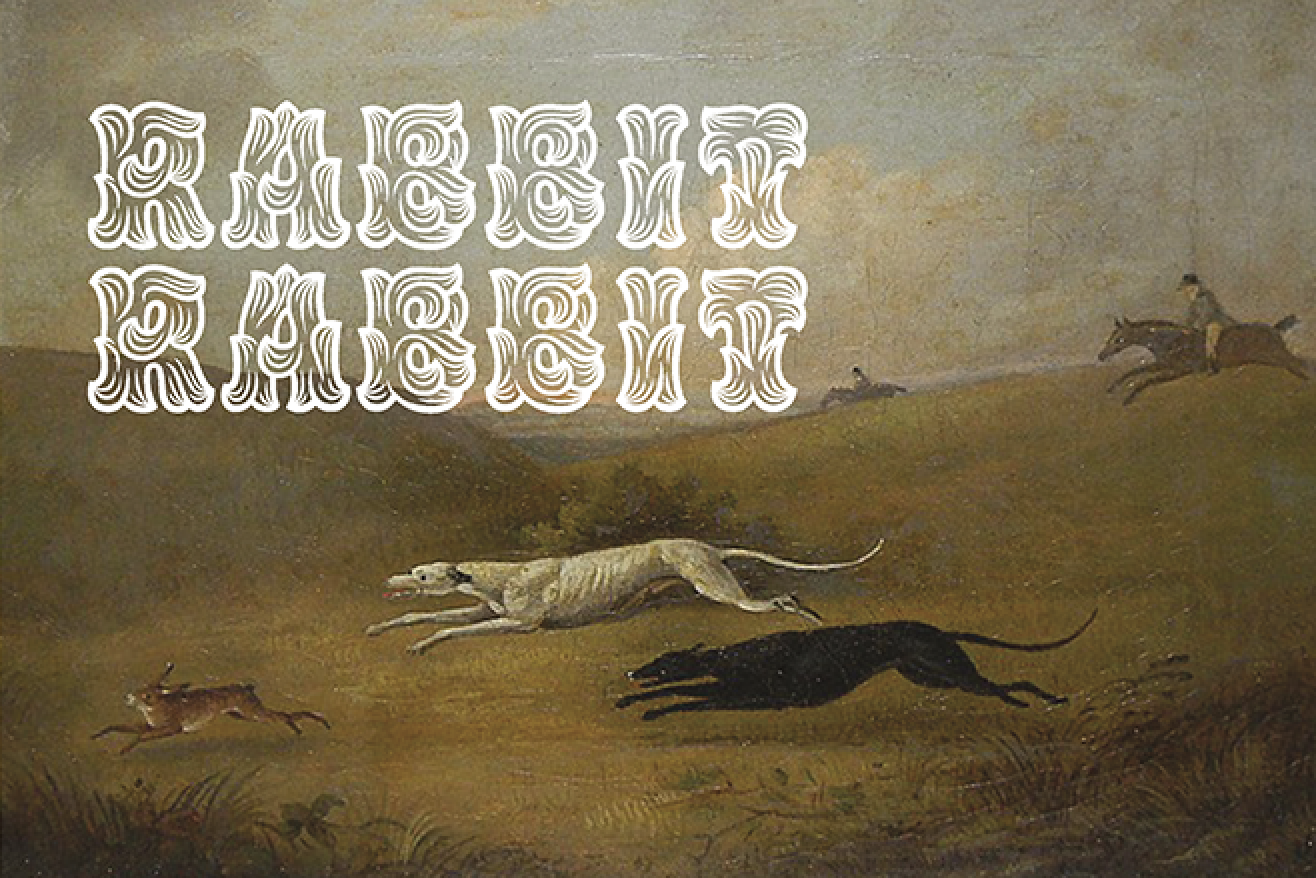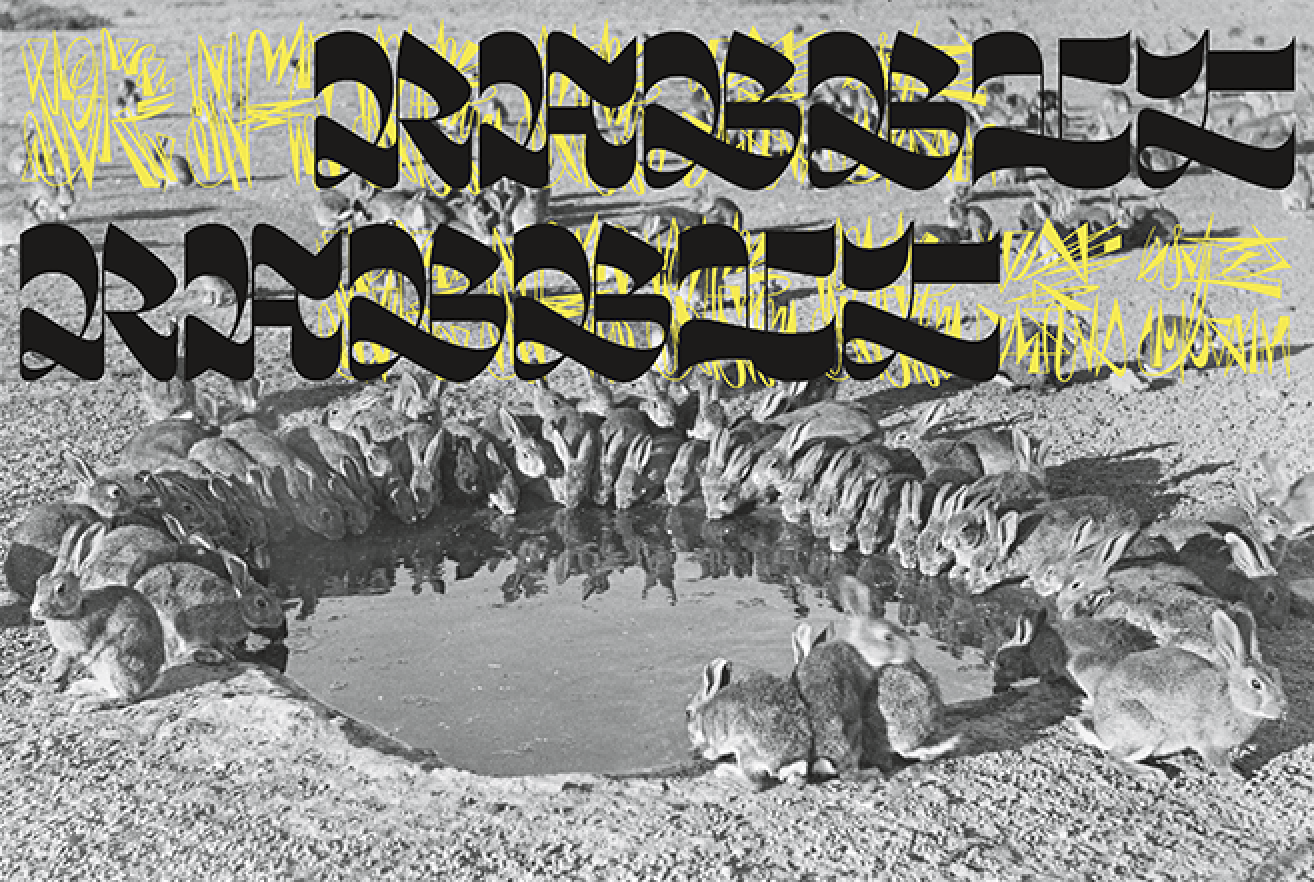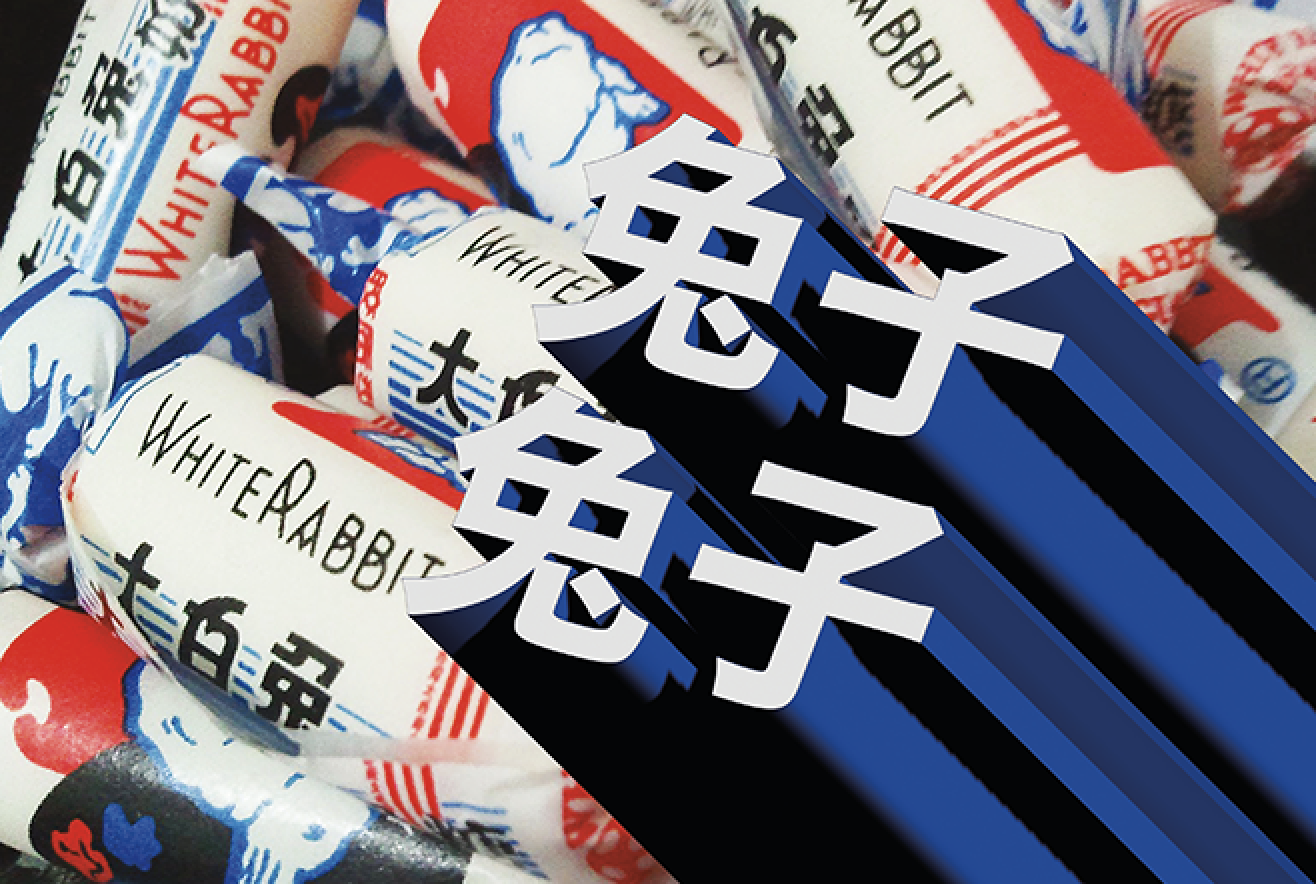Viewers Like You
Holiday Card
2021Uttering the words “Rabbit Rabbit” on the first day of the month is a superstitious periodic mantra, most common in New England. This is connected to the popular notion that the rabbit is a “lucky” animal. It is believed that speaking these words will ensure good fortune for the duration of that month—and especially potent when uttered on the first day of the year.
Throughout the world “the rabbit (or hare) has played a role in folklore quite out of proportion to its diminutive size and timorousness.” ¹ It’s also ever-present in American popular culture, from Looney Tunes to Minecraft, Br’er Rabbit to the March Hare.
Every year since we have been Viewers Like You, we’ve created a Holiday Card that combines a winter tradition, a place in the world, and a related recipe (2021 recipe: Big pot of Texas black eyed peas) ² In 2014, we got a bee in our bonnet and created not one, but twelve Rabbit Rabbit expressions, one per month. Each design represents a different tradition, from fable through modern legend, to carry you through the whole year. For a plethora of reasons, pragmatic to conceptual, for our 2021 edition, we breathed new life into the original series, with a few updates.
Below you’ll find each card design, plus a little context. All the research was culled from the internet, with a dash of our personal perspective.
May your New Year be fertile and w(r)ascally,
Jennifer & David
Image: Cosimo, Piero di. 1490. Venus, Cupid, and Mars. Oil on canvas. Staatliche Museen, Berlin. Type: Orwellian by Shiva Nallaperumal, Lost Type Co-op (2015) following Caslon & Catherwood reversed stress Italian (1821) — losttype.com
FERTILITYRabbits are often associated with fertility—active procreation or just practice—and are legendary for their ability to reproduce fast and furiously. A mother rabbit can have forty or more babies a year!
However, in antiquity, the hare or rabbit represented romantic love, lust, abundance, and fecundity. Pliny the Elder recommended the meat of the hare as a cure for sterility, and wrote that a meal of hare enhanced sexual attraction for a period of nine days. Hares were associated with the Artemis, goddess of wild places and the hunt, and newborn hares were not to be killed but left to her protection. Rabbits were sacred to Aphrodite, the goddess of love, beauty, and pleasure—for rabbits had “the gift of Aphrodite” (fertility) in great abundance. In Greece, the gift of a rabbit was a common love token from a man to his male or female lover. In Rome, the gift of a rabbit was intended to help a barren wife conceive. In Egyptian myth, hares were also closely associated with the cycles of the moon, which was viewed as masculine when waxing and feminine when waning. Hares were likewise believed to be androgynous, shifting back and forth between the genders—not only in ancient Egypt but also in European folklore right up to the 18th century. You also find hares in Renaissance art, celebrating playful sexuality, like in the painting above by Piero di Cosimo. ❦
Image: Pevney, Joseph, 1967. ‘The Trouble with Tribbles’. Star Trek. Type: Kink A by Ellmer Stefan, The Pyte Foundry “52 project” (2016) in the spirit of Wells & Webbs medially fractured Roman Grotesque (1840) — thepytefoundry.net
THE TROUBLE WITH TRIBBLESTribbles are fictional animals in the Star Trek universe who first appeared in the episode that aired on December 29, 1967, titled “The Trouble with Tribbles.” They are depicted as small, furry, soft, gentle, attractive, and slow-moving, and they usually produce a soothing purring or cooing sound when stroked, all of which are endearing traits to humans, Vulcans, and half-human Vulcans.
However, because Tribbles reproduce enormously fast, and consume exponentially larger and larger amounts of food as they multiply and move stealthily from one place to another, Starfleet considers them dangerous organisms and forbids their transportation. The Klingons, in whose presence tribbles produce a convulsive, shrieking reaction, go as far as to consider them “mortal enemies,” as stated in the Star Trek: Deep Space Nine episode “Trials and Tribble-ations.”
The expression “multiplying like Tribbles” has also become commonplace in the context of science fiction or technology. ❦
Image: Gilliam, Terry, and Terry Jones. 1975. Monty Python and the Holy Grail. Type: Radiator Italic by Ellmer Stefan, The Pyte Foundry “52 project” (2016) — thepytefoundry.net
THE KILLER RABBIT OF CAERBANNOGIn the film, Monty Python and the Holy Grail, King Arthur’s Knights of the Round Table are led to the Cave of Caerbannog by Tim the Enchanter. Caerbannog is the home of the Legendary Black Beast of Aaaaarrrrrrggghhh, and is guarded by an unknown, legendary monster. King Arthur and his knights arrive at the Cave and find that they must face its guardian beast. Tim verbally paints a picture of a terrible monster with “nasty, big, pointy teeth!”, so terrifying that Sir Robin soils his armor at the mere description. When the beast appears to be an innocuous white rabbit, surrounded by the bones of the dead, Arthur and his knights no longer take the threat seriously.
Ignoring Tim’s continued warnings, King Arthur orders Bors (Terry Gilliam) to chop its head off. Bors confidently approaches it, sword drawn, and is immediately decapitated by the rabbit. Despite their initial shock, Sir Robin—soiling his armor again—and Tim’s loud scoffing, the knights attack in force. But the rabbit injures several of the knights and kills Gawain and Ector with ease. The knights themselves have no hope of killing or injuring the rabbit. Arthur panics and shouts for the knights to retreat. “RUN AWAAAAAY! RUN AWAAAAAY!” Knowing they cannot risk attacking again, they try to figure out another way to defeat the beast. The Holy Hand Grenade of Antioch is ultimately used to kill it and allow the quest to proceed.
The idea for the rabbit in the movie was taken from the façade of the cathedral of Notre Dame de Paris, illustrating the weakness of cowardice by showing a knight fleeing from a rabbit. ❦
Image: McConnell, Bob. n.d. The Jackalope. Michigan State University Museum. Type: Polymer by Ellmer Stefan, The Pyte Foundry “52 project” (2016) — thepytefoundry.net
JACKALOPEThe jackalope is a mythical animal of North American folklore—a so-called “fearsome critter”—described as a jackrabbit with antelope horns or deer antlers. The word “jackalope” is a portmanteau of “jackrabbit” and “antelope.”
The story of the jackalope was popularized in Wyoming in the 1930s after a local hunter used taxidermy skills to graft deer antlers onto a jackrabbit carcass, selling the creature to a local hotel. It is possible that the tales of jackalopes were inspired by sightings of rabbits in Western United States and Mexico, from the 1880s–1930s, infected with the Shope papilloma virus. This infection causes the growth of horn- and antler-like tumors in various places on a rabbit's head and body.
And yet, the concept of an animal hybrid occurs in many cultures, throughout history, such as the griffin and the chimera. Mythological references to a horned rabbit creature can also be found in the Huichol and Aztec legends of Central America, as are stories about similar hybrid rabbits exist in alpine and Scandinavian regions of Europe (the Wolpertinger in Germany, the Blutschink in Austria, the Dahu in Switzerland and France, and the Medelpad in northern Sweden.)
Reportedly, in the US, jackalopes are extremely shy unless approached. Legend also has it that female jackalopes can be milked—as they sleep, belly up—and that the milk can be used for a variety of medicinal purposes. ❦
Type: GT Flexa by Dominik Huber with Marc Kappeler, Grilli Type (2020) — grillitype.com
NANABOZHOOne of the most important figures in most bodies of cultural mythology is that of the trickster. They come in many guises, some of them human, more of them animal. One of the forms which has had important extensions in modern popular culture is that of the rabbit: Bugs Bunny, Br’er Rabbit and El-ahrairah from Richard Adam’s Watership Down come to mind. Similar to the coyote, the rabbit as trickster animal is popular in Native American culture, too.
The Ojibway and Algonquian hero Nanabozho is one such trickster figure, and can be a bit of a rascal. But unlike trickster figures in some tribes, he does not model immoral and seriously inappropriate behavior—Nanabozho is a virtuous hero and a dedicated friend and teacher of humanity. Though he may behave in mischievous, foolish, and humorous ways in the course of his teaching, Nanabozho never commits crimes or disrespects Native culture and is viewed with great respect and affection by Anishinabe people.
Stories about Nanabozho vary considerably from community to community. Nanabozho is usually said to be the son of either the West Wind or the Sun, and since his mother died when he was a baby, Nanabozho was raised by his grandmother Nokomis. In some tribal traditions Nanabozho is an only child, but in others he has a twin brother or is the eldest of four brothers. The most important of Nanabozho's brother figures is Chibiabos or Moqwaio, Nanabozho's inseparable companion (often portrayed as a wolf) variously said to be his twin brother, younger brother, or adopted brother. Nanabozho is associated with rabbits and is sometimes referred to as the Great Hare (Misabooz), although he is rarely depicted as taking the physical form of a rabbit. ❦
Image: Wolstenholme, Dean Snr. early 19th c. Robert Poole’s Greyhounds, Pigeon, and Polecat. Oil on canvas. Private collection. Type: Hobeaux Rococeaux by James Edmondson, OH no Type Company (2015) — ohnotype.co
HARE COURSINGIn medieval times, a hawk or falcon would have been used to hunt and catch hares as they exited the warren burrow. While this hunting style (Falconry) is still occasionally used, especially in the British Isles where it remains popular, the sport of hare coursing seems downright compassionate.
Hare coursing is the pursuit of hares with greyhounds and other sighthounds, which chase the hare by sight and not by scent. It is a competitive sport, in which dogs are tested on their ability to run, overtake and turn a hare, rather than a form of hunting, aiming at the capture of game.
Opposition from activists concerned about animal welfare isn’t strictly a modern protest. In 1892, the Lady Florence Dixie criticized hare coursing as an “aggravated form of torture” and the League Against Cruel Sports was established in 1924 to campaign against hare coursing—and continues to believe that it’s wrong to expose animals to the risk of injury or death for human entertainment. On the other side of the coin, coursing has long enjoyed the fame of being known as “the noblest of field sports” precisely because the death of the hare is not the aim of the sport. Under most regulated forms of coursing only two hounds pursue the hare, the dogs competing against each other for a short time, allowing the hare a significant chance of escape.
Whether for sporting or hunting purposes, hare coursing in Europe was historically restricted to landowners and the nobility, who used their personal sighthounds, the ownership of which was at certain historic times prohibited among the lower social classes. ❦
Type: Gothic Paneled was patented March 3, 1874 (US Design Patent No 7,230) by William H Page — woodtyperesearch.com
MINECRAFTIn the digital game Minecraft, rabbits or bunnies are passive mobs. Unlike most other mobs, rabbits hop around aimlessly instead of walking, and are moderately fast. They will approach players holding carrots or dandelions, and will turn to look at players from a much farther distance than other mobs. Like other passive mobs, they will panic and randomly run around if you hit them.
Rabbits will find and eat mature carrot crops. When eaten, the crops will not drop anything.
Wild wolves will track down and kill any rabbits, and in turn, rabbits will flee from all nearby wolves. Tamed wolves will not give chase, however, unless you were to hit the rabbit first.
Naming a rabbit Toast (using either a name tag or a renamed spawn egg) will turn it into Toast—a rabbit textured like a Black Dutch Rabbit, with a large black & white patch and more black fur around the face than the natural black & white spotted rabbit. Other than its name and skin, Toast behaves exactly like a normal rabbit.
Also, there’s a special rabbit that is white with red eyes. This rabbit is not passive but will follow and try to kill you. When it does, the death message states: [Playername] was slain by The Killer Rabbit of Caerbannog . ❦
Image: Mules, M. W. 1938. Type: Boogy Brut by Julia Joffre, Yoann Minet, & Camille Prandi of Bureau Brut & Julien Priez of Boogy Paper (2020) — bureaubrut.com
OKUNOSHIMAAs islands that are occupied by wild animals go, Okunoshima, better known as Usaga Jima or Rabbit Island, is probably the cutest.
Situated in the East Sea/Inland Sea of Japan, the small island is occupied by multitudes of wild rabbits that roam the forests and paths, chase tourists, appear in viral videos and just generally lounge around. They also provide a much needed counterbalance to the island's otherwise dark history—as the production site for Japan's chemical weapons during the Second World War.
Of course, Japan being the birthplace of kawaii—the distinct cultural appreciation of all things cute—the bounding herds of friendly rabbits are a much bigger attraction than the Poison Gas Museum.
While the true source of the rabbits remains a mystery, it’s thought that the origins of the island's fluffy residents is intertwined with its history as manufacturer of chemical weapons. Some claim the rabbits that live there now are relatives of the test bunnies that were freed by the workers at the end of the war, where they bred (presumably “like rabbits”) until they reached their current population, which is potentially in the thousands. ❦
Image: Warner Brothers Pictures, Inc. 1948. Bugs Bunny. Tytpe: Gothic Bold by Hamilton Manufacturing Company (September 1891)
BUGS BUNNYBugs is an anthropomorphic gray hare or rabbit who is famous for his flippant, insouciant personality, a pronounced New York accent, his portrayal as a trickster, and his catch phrase “Eh… What’s up, doc?”, usually said while munching on a carrot.
Characterized as being clever and capable of outsmarting anyone who antagonizes him, Bugs has delightfully outwitted Elmer Fudd, Yosemite Sam, Daffy Duck, Porky Pig, the Tasmanian Devil, Marvin the Martian, Wile E. Coyote, Cecil Turtle, Witch Hazel, Rocky and Mugsy, The Crusher, Beaky Buzzard, Willoughby the dog, Count Blood Count and a host of others.
While Bugs almost always wins these conflicts, he’s often depicted as being bullied, cheated, or threatened by antagonists while minding his own business. This justifies his subsequent trickster antics as retaliation or self-defense. Bugs will usually try to placate the antagonist and avoid conflict, but when an antagonist pushes him too far, Bugs has been known to break the fourth wall by “communicating” with the audience, most notably with his catchphrase “Of course you realize this means war!” before he retaliates—and the retaliation is devastating.
Self-reflective as he is, Bugs also readily admits his own deviousness with the adorable: “Gee, ain't I a stinker?”. ❦
Type: QFWFQ by Ellmer Stefan, The Pyte Foundry “52 project” (2016) — thepytefoundry.net
WATERSHIP DOWNWatership Down is your classic adventure novel, written by English author Richard Adams, and published in 1972. Set in south-central England, the story features a small group of rabbits living in their natural environment, but are anthropomorphized—possessing their own culture, language (Lapine), proverbs, poetry, and mythology. The novel follows the rabbits as they escape the destruction of their warren and seek a place to establish a new home, encountering perils and temptations along the way.
The book explores epic themes of exile, survival, heroism, leadership, and political responsibility. These hero’s journey theme derives from the author’s exposure to the works of Joseph Campbell, especially his study of comparative mythology, as well as on Carl Jung’s view of the unconscious mind, that “all the stories in the world are really one story.”
Along with A Wrinkle in Time, Winnie the Pooh, and Bridge to Terabithia, Watership Down was a banned children’s book. Those convincing local schools or libraries to ban the book cite that it encourages a belief in the occult because one of the rabbits has psychic abilities. ❦
WHITE RABBIT CANDYWhite Rabbit (大白兔奶糖, literally meaning ‘big white rabbit milk candy’) is a Chinese milk-flavored candy. Not surprisingly, this taffy candy tastes just like vanilla milk. But maybe its most famous feature is being wrapped in a thin, edible paper wrapping made of sticky rice—meant to be eaten along with the rest of the candy—but not the printed waxy one in the image above.
Created in 1943 by the Aipixi Candy Factory of Shanghai when one of their salesmen tried a milk candy from England and brought the idea back to the office. The package’s color scheme of red, blue and black against a white background, has resulted in a distinctive design that hasn’t changed since the 1950s.
During the hard times of the Chinese Cultural Revolution, it was usual to dissolve three or four White Rabbits in hot water to get an inexpensive glass of sugary milk. White Rabbit being promoted as a nutritional product through the slogan “Seven White Rabbit candies are equivalent to one cup of milk” helped this elixir to take hold.
Nowadays, among the vast array of snacks that any self-respecting Chinese family offers when visiting relatives and friends during the Lunar New Year, one of them is invariably a bag of White Rabbit. ❦
Image: Tenniel, John illus. 1865. Alice’s Adventures in Wonderland by Lewis Carroll. Type: Monotype Modern Wide, Series No 25
MARCH HAREHares have long been thought to behave excitedly in March, which is their mating season. Lewis Carroll is the most notable author to have used this idea in his popular Alice’s Adventures in Wonderland.
Haigha, a white rabbit, the March hare character, appears at the very beginning of the book in chapter one, wearing a waistcoat, while frantically muttering “Oh dear! Oh dear! I shall be too late” Alice consequently follows him down the rabbit hole into Wonderland.
To be as “mad as a March hare” is an English idiomatic phrase derived from the observed antics, said to occur only in the March breeding season of the hare. This odd behavior includes boxing at other hares, jumping vertically for seemingly no reason and generally displaying abnormal behavior. The phrase is an allusion that can be used to refer to any other animal or human who behaves in the excitable and unpredictable manner of a “March hare.”
“Mad as a March hare” is a common British English phrase, both now and in Carroll’s time. ❦
¹ Leach, Maria, and Jerome Fried. 1984. Funk & Wagnalls Standard Dictionary of Folklore, Mythology, and Legend. San Francisco: Harper & Row. pg 164.
² The Southern Food tradition of eating black eyes peas for the new years originated on Dec. 31, 1862, Freedom’s Eve. On that day, enslaved Africans congregated in churches in the south, eager to hear the news that the Emancipation Proclamation had set them free. Other Southern Food traditions include cornbread (the sunny-colored, many-seeded vegetable represents growth & expansion), greens (ensures you’re financially secure, ‘natch). and pork (because pigs root around with their snouts in a forward motion).
Read more on the broader story about African Americans’ food traditions.
